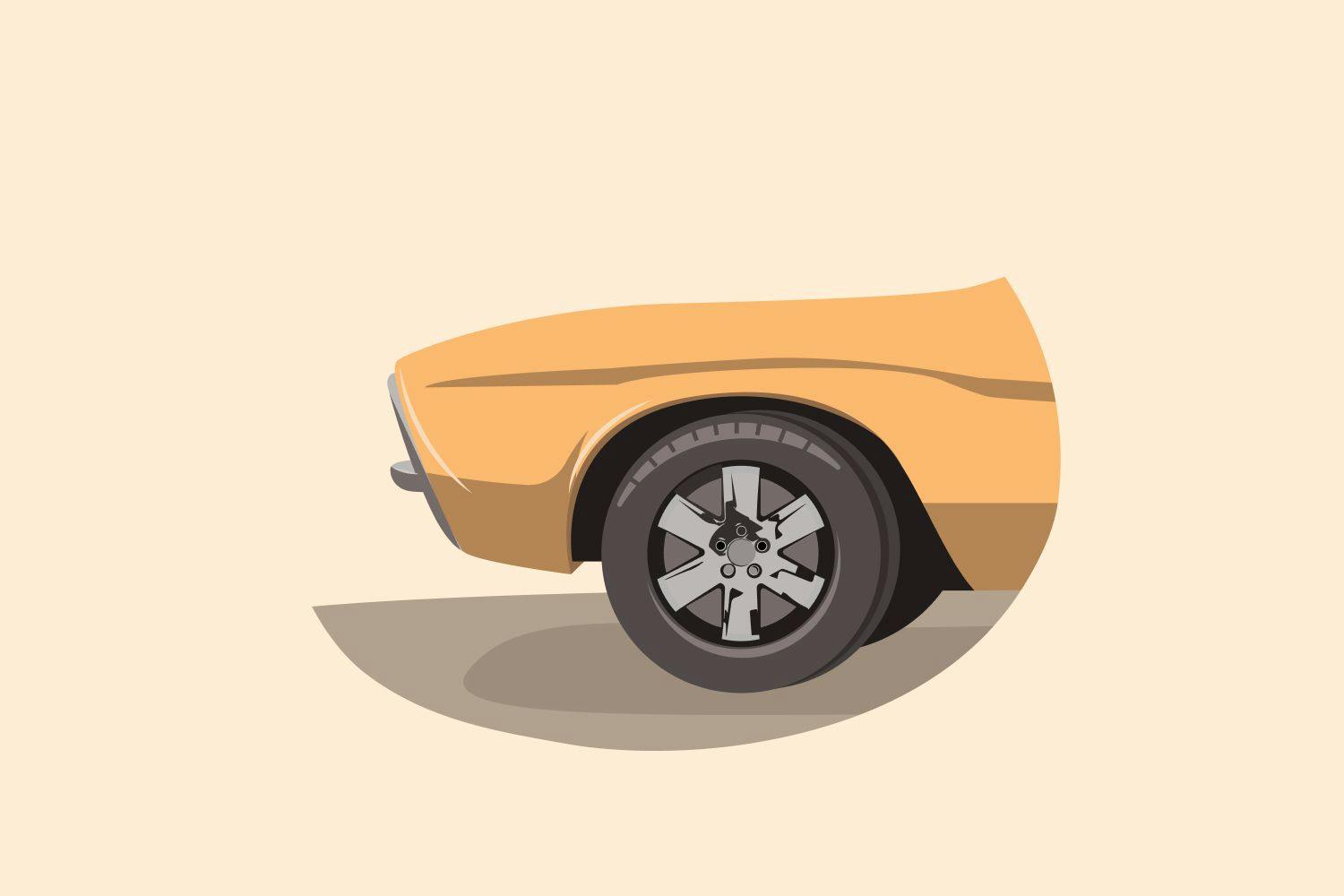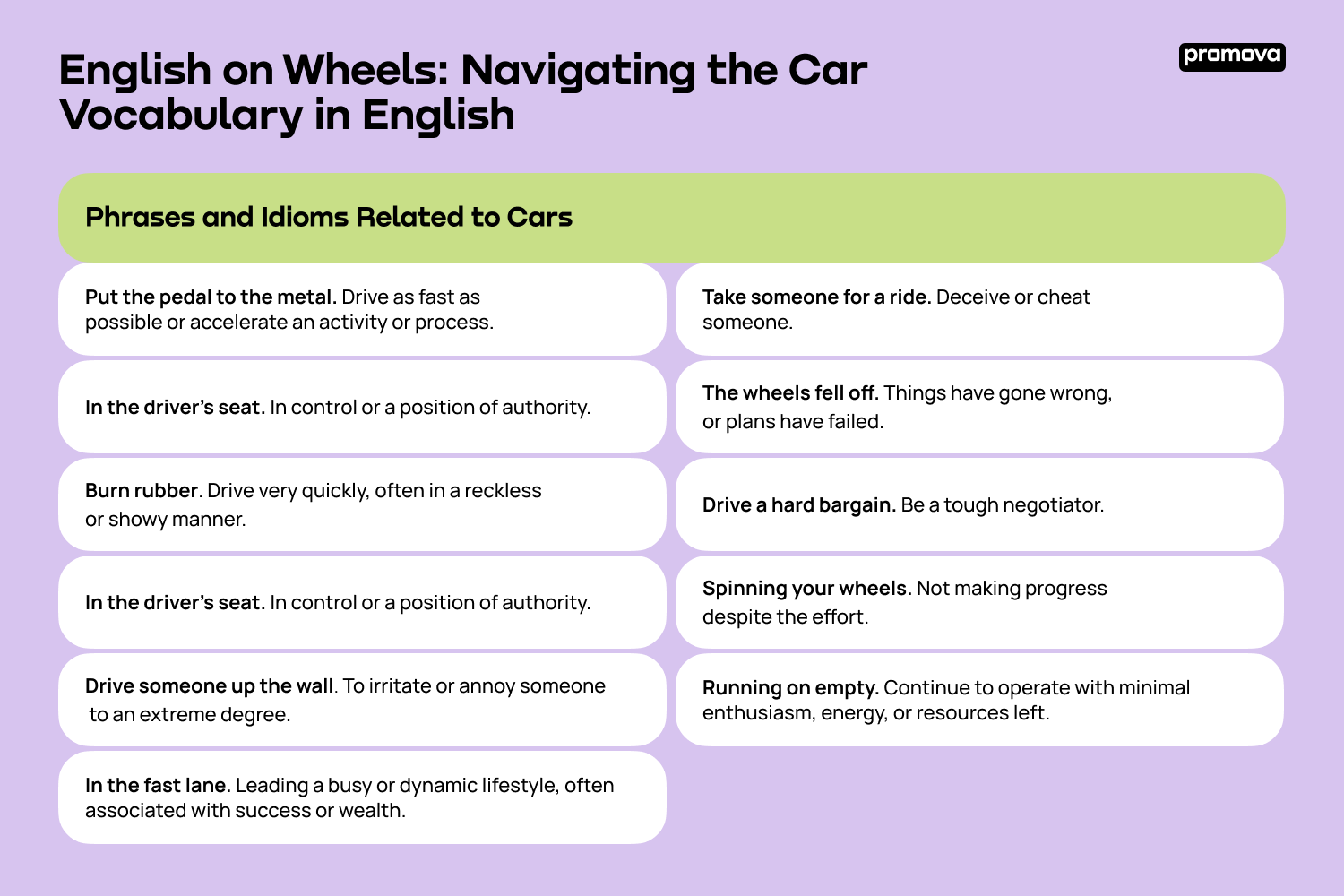English on Wheels: Navigating the Car Vocabulary in English

Contents
The language of cars can sometimes seem like a foreign dialect, even to native English speakers. With so many diverse types of automobiles and a vast array of technical performance descriptors, it’s easy to get lost in the jargon.
That’s why we’ve compiled an essential guide to car words tailored for English learners. We will explore the terminology used to describe cars, their features, and functions in detail.
A Spectrum of Vehicles: Understanding Different Types of Automobiles
From compact hatchbacks to imposing SUVs, the spectrum of vehicles is broad and vibrant. Each type carries its charm and utility, and it’s essential to understand what sets them apart. From sedans and coupes to trucks and vans, we’ll walk you through the features and characteristics of each car type below:
- Minivan [ˈmɪn.i.væn]. A versatile vehicle with three rows of seating, perfect for families.
- Sedan [səˈdæn]. A common 4-door car type with separate engine, passenger, and cargo compartments.
- SUV (Sport Utility Vehicle) [ˈɛs juː ˈviː]. A blend of road-going passenger and off-road vehicles.
- Coupe [kuːˈpeɪ]. A car with two doors and a sloping rear, often sporty in appearance.
- Hatchback [ˈhætʃ.bæk]. A compact car with a rear door that swings upward to provide access to a storage area.
- Pickup truck [ˈpɪkˌʌp ˌtrʌk]. A vehicle with a passenger cab and an open cargo area that is typically used for transporting goods.
- Sports car [ˈspɔːrts kɑːr]. An automobile designed for high-speed performance, often with two seats and two doors.
- Off-roader [ˈɒfˈroʊdər]. A vehicle built to be driven off paved surfaces, often used for adventure and exploration.
- MPV (Multi-Purpose Vehicle) [ˌɛm piː ˈviː]. A large vehicle with flexible interior configurations to accommodate passengers, cargo, or both.
- Crossover [ˈkroʊsˌoʊvər]. A blend of a sedan and an SUV, offering the comfort of a car and the utility of an SUV.
These examples of cars in English represent a mere fraction of the types out there. But understanding their basic features and functions is an excellent place to start when navigating the world of automobiles. Pronunciation can be challenging, but with practice and patience, you’ll become a pro at car lingo in no time.
Decoding the Outer Parts of a Car
Automobiles are more than just a means of transportation; they are intricate pieces of engineering with their unique vocabulary. So, let’s delve into the key terms for the exterior components of a car:
- Hood [hʊd].
- Trunk [trʌŋk].
- Fender [ˈfɛndər].
- Bumper [ˈbʌmpər].
- Grille [grɪl].
- Door [dɔːr].
- Roof [ruːf].
- Window [ˈwɪndoʊ].
- Mirror [ˈmɪrər].
- Headlight [ˈhɛdˌlaɪt].
- Taillight [ˈteɪlˌlaɪt].
- Tire [ˈtaɪər].
- Wheel [wil].
The external parts of a car contribute to the overall aesthetic and design of the vehicle. Knowing the terminology allows you to appreciate the engineering mastery of car dealers.
1
Navigating the Inside of a Car
Just as the exterior is adorned with distinct features, the interior is a marvel of design and comfort. Each component inside a vehicle has a specific role in providing a safe and comfortable ride. Let’s take a closer look at some common terms for the interior parts:
- Steering wheel [ˈstiːrɪŋ wiːl].
- Rearview mirror [ˈriːrˌvjuː ˈmɪrər].
- Seats [siːts].
- Seat belt [siːt bɛlt].
- Gear shift [gɪər ʃɪft].
- Pedals [ˈpɛdəlz].
- Glove compartment [glʌv kəmˈpɑːrtmənt].
- Car radio [kɑːr ˈreɪdioʊ].
- Sun visor [sʌn ˈvaɪzər].
- Air vents [eər vɛnts].
- Handbrake (or parking brake) [hændbreɪk].
- Cup holders [kʌp ˈhoʊldərz].
- Armrest [ɑːrmrɛst].
- Odometer [oʊˈdɑːmɪtər].
- Fuel gauge [fjuːl ɡeɪdʒ].
As you can see, many components work together to create a complete driving experience. Familiarizing yourself with these essential car words will help you understand how to drive a car and ensure your ride is safe and enjoyable.
Under the Hood: Car Words Related to Performance and Functionality
When we peek under the hood of a car, we encounter a world of mechanics and performance. Every part is designed to work harmoniously, providing the power and efficiency we need on the road. This section will introduce keywords related to functionality and performance:
- Engine [ˈɛndʒɪn].
- Transmission [trænsˈmɪʃən].
- Exhaust [ɪɡˈzɔːst].
- Brake [breɪk].
- Accelerator [əkˈsɛləreɪtər].
- Suspension [səˈspɛnʃən].
- Battery [ˈbætəri].
- Radiator [ˈreɪdiˌeɪtər].
- Fuel tank [fjuːl tæŋk].
- Spark plug [spɑːrk plʌg].
- Alternator [ˈɔːl.tərˌneɪ.tər].
- Timing belt [ˈtaɪmɪŋ bɛlt].
- Air filter [eər fɪltər].
- Oil filter [ɔɪl fɪltər].
- Fuel pump [fjuːl pʌmp].
- Clutch [klʌtʃ].
- Starter motor [ˈstɑːrtər ˈmoʊ.tɔːr].
- Distributor [dɪˈstrɪb.jə.tər].
- Carburetor [kɑːrˈbjuːreɪtər].
- Power steering [ˈpaʊər ˈstiːrɪŋ].
Having this knowledge at your fingertips allows you to understand and discuss the mechanics of cars more effectively. It enhances your English vocabulary and provides a window into the fascinating world of automotive engineering.
Terms to Describe How a Car Functions
In addition to the technical parts, terms describe how a car performs on the road. These descriptors provide insight into its handling and capabilities in different conditions. Here are some of the words associated with cars:
- Acceleration [ækˌsɛləˈreɪʃən].
- Handling [ˈhændlɪŋ].
- Fuel efficiency [fjuːl ɪˈfɪʃənsi].
- Braking [ˈbreɪkɪŋ].
- Traction [ˈtrækʃən].
- Mileage [ˈmaɪlɪdʒ].
- Horsepower [ˈhɔːrspaʊər].
- Torque [tɔːrk].
- Payload [ˈpeɪloʊd].
- Towing capacity [ˈtoʊɪŋ kəˈpæsɪti].
Understanding these words related to cars will help you assess an auto’s capabilities and determine if it meets your needs. It also enables you to communicate better with others about vehicles in everyday conversation and technical settings.
Cruising the Streets: Car-Related Verbs
Car vocabulary doesn’t just revolve around the physical aspects of a vehicle; it also extends to the motions we perform while using them. These verbs can help English learners articulate various actions related to driving and maintaining an auto. Let’s take a peek at some of the verbs for cars:
- Drive [draɪv].
- Park [pɑːrk].
- Brake [breɪk].
- Accelerate [əkˈsɛləˌreɪt].
- Shift [ʃɪft].
- Refuel [riːˈfjuːl].
- Overtake [ˌoʊvərˈteɪk].
- Reverse [rɪˈvɜːrs].
- Signal [ˈsɪgnəl].
- Fasten [ˈfæsən].
- Repair [rɪˈpɛər].
- Jump-start [ˈdʒʌmpˌstɑːrt].
- Steer [stɪər].
Having a strong grasp of car-related words is crucial for any English learner. They describe our actions while driving and maintaining our vehicles, and they’re ubiquitous in everyday conversation. These words will be handy if you explain how to drive to a friend or discuss car troubles with a mechanic.
Phrases and Idioms Related to Cars
In every language, idioms breathe life into conversations. They’re not only colorful collocations but also mirrors of cultural nuances. For English learners, mastering idiomatic expressions can provide a fascinating insight into the native speakers’ mindsets, especially when the idioms are related to cars and driving. Let’s explore some of them:
- Put the pedal to the metal. Drive as fast as possible or accelerate an activity or process.
- In the driver’s seat. In control or a position of authority.
- Burn rubber. Drive very quickly, often in a reckless or showy manner.
- Drive someone up the wall. To irritate or annoy someone to an extreme degree.
- A Sunday driver. A person who drives slowly and leisurely, often perceived as an obstacle by other drivers.
- In the fast lane. Leading a busy or dynamic lifestyle, often associated with success or wealth.
- Take someone for a ride. Deceive or cheat someone.
- The wheels fell off. Things have gone wrong, or plans have failed.
- Drive a hard bargain. Be a tough negotiator.
- Spinning your wheels. Not making progress despite the effort.
- Running on empty. Continue to operate with minimal enthusiasm, energy, or resources left.

Idiomatic expressions can add color and nuance to your English communication skills. While their literal meanings may seem obscure, they often express ideas and concepts that native speakers universally understand. Try integrating them into your everyday conversations and see the reactions you get. You’ll not only sound more natural, but you’ll also enjoy the fun side of language learning.
Learn Car Vocabulary in English with Promova
Looking to enhance your vocabulary and learn English car terminology? Promova is here to help! Our language-learning platform offers a range of tools and resources to assist you in mastering new words efficiently.
With our app, you can access vocabulary lessons categorized by topics. Whether it’s business jargon, car terminology, or everyday phrases and expressions, we’ve got you covered. Our interactive exercises and quizzes will improve your knowledge and reinforce the correct usage of new words in context.
Plus, our English personalized online classes with expert tutors can help tailor your lessons to meet specific language learning needs. So whether it’s improving pronunciation or gaining confidence in grammar, our tutors can help you achieve your goals!
Sign up with Promova today to enhance your language skills for personal or professional purposes. The first lesson is free, allowing you to explore our platform and experience the ease of language learning.
Conclusion
We’ve come to the end of our linguistic road trip through car terminology. Each term learned adds to your understanding of English and paints a more detailed world picture. Cars and the related vocabulary are deeply embedded in our everyday life and culture. Thus, becoming familiar with these terms will benefit your English language journey and enhance your cultural knowledge.
FAQ
Why is learning car vocabulary important?
Automobiles are a universal part of daily life. Knowing car-related vocabulary can help you discuss, understand, and navigate situations related to driving, maintenance, or even car purchases.
What’s the easiest way to remember car-related words?
One way is to label car parts or images with vocabulary words. Illustrations can be incredibly helpful for memory retention. Additionally, practice these terms in sentences or conversations about vehicles.
What should I do if I don’t understand a car-related word while communicating with someone?
Don’t be afraid to ask for clarification. People will appreciate your trying to learn and improve your vocabulary skills. Keep a dictionary or device with access to the internet handy, so you can quickly look up unfamiliar words on the go.
How can I learn more advanced car vocabulary?
Consider reading automobile magazines like Motor Trend or Autoweek, car reviews, or mechanic manuals for advanced learning. You could also watch car-focused TV shows or YouTube channels. Each source will provide exposure to a more specific set of vocabulary.



Comments